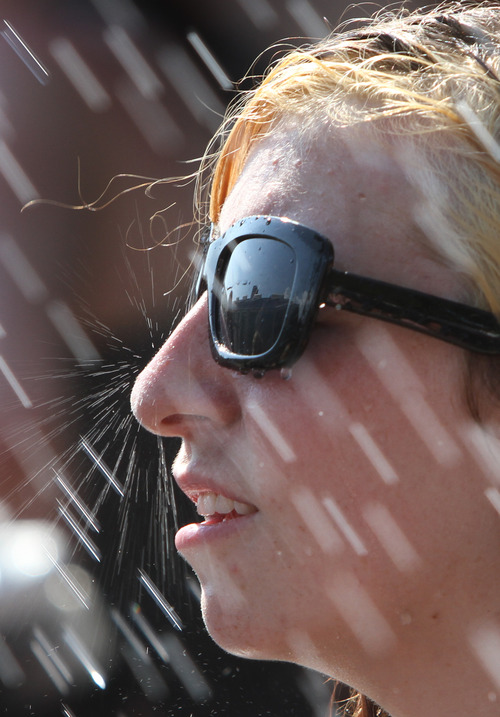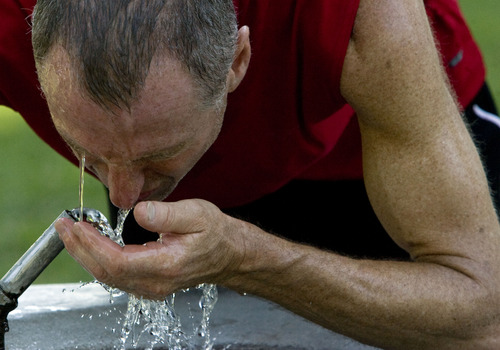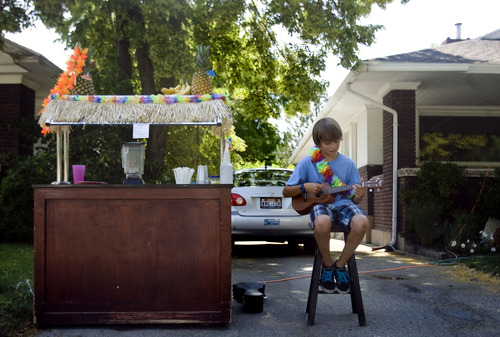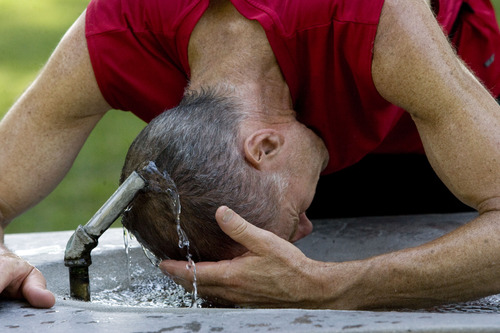This is an archived article that was published on sltrib.com in 2013, and information in the article may be outdated. It is provided only for personal research purposes and may not be reprinted.
For the second day in a row, temperatures blasted through record highs, soaring to 105 degrees in Salt Lake City.
That breaks a record of 104 set in 1979 and continues Friday's record high for the month of June.
Medics tended to a few patients with heat exhaustion at Vans Warped Tour, where revelers cooked while listening to 90 different bands at the Utah State Fairgrounds.
"That's why you come to a festival: to see a diversity of artists. That, and to die of heat stroke," joked John Christianson, trumpeter for the band Reel Big Fish.
Forecasters predicted more sweltering weather through the weekend, with highs at Salt Lake City International Airport rising to 106 degrees Sunday and 105 degrees Monday.
Linda Cheng, a meteorologist for the National Weather Service, explained that the high temperatures are the result of a high pressure system over the western U.S. She also said the warm weather could persist all the way to next weekend. By July Fourth, the Salt Lake Valley should see suddenly-cool-seeming temperatures around 99 degrees.
Other cities along the Wasatch Front also were expected to broil under the heat, with highs Sunday reaching 102 in Ogden and 103 in Provo.
In southern Utah, a heat advisory issued Friday remains in effect until Wednesday night. In Zion National Park, Saturday's high reached 114 degrees, beating a record of 112 set in 1950.
The oldest record broken statewide was in Milford, where a high of 102 degrees beat the record of 100 set in 1909. Richfield's high of 99 degrees tied a record set in 1907.
In some of the state's more remote regions, the hot, dry air also contributed to lightning-sparked wildfires that continued to burn Saturday.
The Wildflower Fire had burned more than 400 acres north of the Simpson Mountains in Tooele County. It was burning uncontained as of Saturday night.
The Death Canyon Fire also continued to burn Saturday on 72 acres in the West Desert, also near the Simpson Mountains, southeast of the Wildflower Fire. It was 20 percent contained as of Saturday night, with full containment expected Sunday.
In the Cove Fort area of Millard County, the Antelope Fire had burned about 1,600 acres since it began about 7 p.m. Friday, according to interagency fire spokesman Don Carpenter. It was 30 percent contained as of Saturday night.
The heat also damaged the southbound on-ramp to Interstate 215 East at 3300 South, according to the Utah Department of Transportation. It was closed much of Saturday night.
The high temperatures also contributed to small power outages around the Salt Lake Valley.
"Extreme heat outside together with high load on system as everyone turns up the air conditioning can combine to put stress on the electrical system. That can result in power outages," said Jeff Hymas, spokesman for Rocky Mountain Power.
While temperatures remain high, Utahns should drink plenty of water, take shelter in cool, shady places and avoid exertion during the hottest parts of the day. Authorities have also stressed that children and pets should not be left in cars. Concerned about older adults who can be more vulnerable to heat-related illnesses, Salt Lake County Aging Services suggested seniors looking for a cool spot to try the county's air-conditioned senior centers or county libraries.
Record high temperatures were reported in Alta at 81 degrees, beating 1979's high of 79; Cedar City airport at 100 degrees, beating 99 degrees in 2007; Escalante at 103 degrees, beating 100 in 1994; Price airport at 100, beating the 1974 high of 98; Brigham Young University at 102, beating 101 in 1990; and Utah Test Range at 101, beating 99 in 2007.
The heat wave is forecast to continue statewide. In Ogden, temperatures are expected to hit 102 degrees Sunday and Monday; Provo 103; Logan, 100; Wendover 102 Sunday and 101 Monday; Duchesne 95 and 93, respectively; Moab 103 and 101; Park City 91 and 92; Cedar City 99 and 98; and St. George 111 and 110.
Austin Green contributed to this report.













